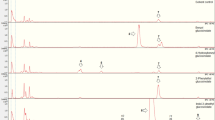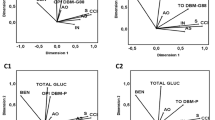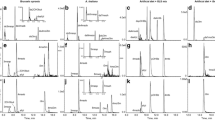Abstract
We measured feeding behavior, feeding damage, and larval growth of the crucifer specialist, Plutella xylostella and the generalist, Spodoptera eridania, on the cotyledons of 14 homozygous lines of Brassica juncea differing in myrosinase activity and glucosinolate profiles. The proportion of time feeding and area damaged by P. xylostella were lower on lines with high myrosinase activities [0.49–0.73 nmol glucose released/mg tissue(fresh weight, FW)/min] than on lines with low myrosinase activities [0.20–0.31 nmol glucose released/mg tissue(FW)/min]. In contrast, the proportion of time feeding and area damaged by S. eridania were not related to myrosinase activity, but were lower on cotyledons of lines with high glucosinolate concentrations [6.8–21.3 μg/g(FW)] than on lines with low glucosinolate concentrations [0.09–0.61 μg/g(FW)]. Relative growth rates (RGR) of both insect species were lower on lines with high glucosinolate concentrations, but were not related to myrosinase activity in the lines. In toxicity experiments that used artificial diets, allyl isothiocyanate, but not allyl glucosinolate, was lethally toxic to neonate P. xylostella (LC50s of 1.54 μmol/g, and ≫100 μmol/g, respectively), whereas isothiocyanate and the glucosinolate were lethally toxic to neonate S. eridania (LC50s of 3.42 and 6.73 μmol/g, respectively). We interpret these results to indicate that myrosinase activity might be more important for plant defense against specialist insects that have adaptations to intact glucosinolates, but less important for defense against generalists, which are susceptible to the intact glucosinolates.
Similar content being viewed by others
REFERENCES
Abbot, W. S. 1925. A method of computing the effectiveness of an insecticide. J. Econ. Entomol. 18:265-267.
Åhman, I. 1986. Toxicities of host secondary compounds to eggs of the Brassica specialist Dasineura brassicae. J. Chem. Ecol. 12:1481-1488.
Bartlet, E., Parsons, D., Williams, I. H., and Clark, S. J. 1994. The influence of glucosinolates and sugars on feeding by the cabbage stem flea beetle, (Psylliodes chrysocephala). Entomol. Exp. Appl. 73:77-83.
Bartlet, E., Mithen, R., and Clark, S. J. 1996. Feeding of cabbage stem flea beetle Psylliodes chrysocephala on high and low glucosinolate cultivars of oilseed rape. Entomol. Exp. Appl. 80:87-89.
Blau, P. A., Feeny, P., nad Contardo, L. 1978. Allylglucosinolate and herbivorous caterpillars: A contrast in toxicity and tolerance. Science 200:1296-1298.
Bodnaryk, R. P. 1997. Will low-glucosinolate cultivars of the mustards Brassica juncea and Sinapis alba be vulnerable to insect pests? Can. J. Plant Sci. 77:283-287.
Bodnaryk, R. P., and Palaniswamy, P. 1990. Glucosinolate levels in cotyledons of mustard, Brassica juncea L. and rape, B. napus L. do not determine feeding rates of flea beetle, Phyllotreta cruciferae (Goeze). J. Chem. Ecol. 16:2735-2746.
Bones, A. M., and Rossiter, J. T. 1996. The myrosinase-glucosinolate system, its organisation and biochemistry. Physiol. Planta. 97:194-208.
Borek, V., Elberson, L. R., Mccaffrey, J. P., and Morra, M. J. 1995. Toxicity of aliphatic and aromatic isothiocyanates to eggs of the black vine weevil (Coleoptera: Curculionidae). J. Econ. Entomol. 88:1192-1196.
Borek, V., Elberson, L. R., Mccaffrey, J. P., and Morra, M. J. 1997. Toxicity of rapeseed meal and methyl isothiocyanate to larvae of the black vine weevil (Coleoptera: Curculionidae). J. Econ. Entomol. 90:109-112.
Borek, V., Elberson, L. R., Mccaffrey, J. P., and Morra, M. J. 1998. Toxicity of isothiocyanates produced by glucosinolates in Brassicaceae species to black vine weevil eggs. J. Agric. Food Chem. 90:109-112.
Brown, J. 1996. Developing canola-quality oil and seed meal from yellow mustard (Sinapis alba L.), in Proceedings of the Pacific Northwest Canola Meeting. Great Falls, Montana.
Brown, P. D., and Morra, M. J. 1995. Glucosinolate-containing plant tissues as bioherbicides. J. Agric. Food Chem. 43:3070-3074.
Chew, F. S. 1988a. Biological effects of glucosinolates, pp. 155-181, in H. G. Cutler (ed.). Biological Active Natural Products. American Chemical Society, Washington, D.C.
Chew, F. S. 1988b. Searching for defensive chemistry in the cruciferae, or, do glucosinolates always control interactions of cruciferae with their potential herbivores and symbionts? No!, pp. 81-112, in K. C. Spencer (ed.). Chemical Mediation of Coevolution. American Institute of Biological Sciences, Academic Press, San Diego, California.
Coleman, R. A., Barker, A. M., and Fenner, M. 1996. Cabbage (Brassica oleracea var. capitata) fails to show wound-induced defense against a specialist and a generalist herbivore? Oecologia 108:105-112.
David, W. A. L., and Gardiner, B. O. C. 1962. Oviposition and the hatching of eggs of Pieris brassicae in a laboratory culture. Bull. Entomol. Res. 53:91-109.
David, W. A. L., and Gardiner, B. O. C. 1966. Mustard oil glycosides as feeding stimulants for Pieris brassicae larvae in a semisynthetic diet. Entomol. Exp. Appl. 9:247-255.
Eigenbrode, S. D., and Pillai, S. K. 1998. Neonate Plutella xylostella L. responses to surface wax components of a resistant cabbage (Brassica oleracea L.). J. Chem. Ecol. 24:1611-1627.
Eigenbrode, S. D., Espelie, K. E., and Shelton, A. M. 1991. Behavior of neonate diamondback moth larvae on leaves and extracted leaf waxes of resistant and susceptible cabbages. J. Chem. Ecol. 17:1691-1704.
Feeny, P. 1977. Defensive ecology of the Cruciferae. Ann. Mo. Bot. Gard. 64:221-234.
Feeny, P., Paauwe, K. L., and Demong, N. J. 1970. Flea beetles and mustard oils: host plant specificity of Phyllotreta cruciferae and P. striolata adults (Coleoptera: Chrysomelidae). Ann. Entomol. Soc. Am. 63:832-841.
Fenwick, G. R., Heaney, R. K., and Mullin, W. J. 1983. Glucosinolates and their breakdown products in food and food plants. CRC Criti. Rev. Food Sci. Nutr. 18:123-201.
Gordon, H. T. 1968. Quantitative aspects of insect nutrition. Am. Zool. 8:131-138.
Gupta, P. D., and Thorsteinson, A. J. 1960a. Food plant relationships of the diamond-back moth (Plutella maculipennis (Curt.)) 1. gustation and olfaction in relation to botanical specificity of the larvae. Entomol. Exp. Appl. 3:241-250.
Gupta, P. D., and Thorsteinson, A. J. 1960b. Food plant relationships of the diamond-back moth (Plutella maculipennis (Curt.)) 2. sensory regulation of oviposition of the adult female. Entomol. Exp. Appl. 3:305-314.
Hicks, K. P. 1974. Mustard oil glucosides: Feeding stimulants for adult cabbage flea beetles, Phyllotreta cruciferae (Coleoptera: Chrysomelidae). Ann. Entomol. Soc. Am. 67:261-264.
Hopkins, R. J., Ekbom, B., and Henkow, L. 1998. Glucosinolate content and susceptibility for insect attack of three populations of Sinapis alba. J. Chem. Ecol. 24:1203-1216.
Kondra, Z. P., and Stefansson, B. R. 1990. Inheritance of the major glucosinolates of rapeseed (B. napus) meal. Can. J. Plant Sci. 50:643-647.
Li, Q. 1999. Responses of insect herbivores to varying myrosinase activity and glucosinolate concentration in Brassica. MS thesis. University of Idaho, Moscow, Idaho.
Louda, S. M., and Collinge, S. K. 1992. Plant resistance to insect herbivores: A field test of the environmental stress hypothesis. Ecology 73(1):153-169.
Louda, S., and Mole, S. 1991. Glucosinolates: chemistry and ecology, pp. 123-164, in G. A. Rosenthal and M. R. Berenbaum (eds.). Herbivores: Their Interactions with Secondary Plant Metabolites, 2nd ed. Vol. 1: The Chemical Participants. Academic Press, New York.
Martin, P., and Bateson, P. 1993. Measuring Behavior: An Introductory Guide. Cambridge University Press, Cambridge, UK.
Mccloskey, C., and Isman, M. B. 1993. Influence of foliar glucosinolates in oilseed rape and mustard on feeding and growth of the Bertha armyworm, Mamestra configurata Walker. J. Chem. Ecol. 19:249-266.
Mitchell-olds, T., Siemens, D., and Pedersen, D. 1996. Physiology and costs of resistance to herbivory and disease in Brassica. Entomol. Exp. Appl. 80:231-237.
Nault, L. R., and Styer, W. E. 1972. Effects of sinigrin on host selection by aphids. Entomol. Exp. Appl. 15:423-427.
Nayar, J. K., and Thorsteinson, A. J. 1963. Further investigations into the chemical basis of insect-host plant relationships in an oligophagous insect, Plutella maculipennis. Can. J. Zool. 41:923-929.
Newman, R. M., Hanscom, Z., and Kerfoot, W. C. 1992. The watercress glucosinolate-myrosinase system: A feeding deterrent to caddisflies, snails and amphipods. Oecologia 92:1-7.
Pivnick, K. A., Lamb, R. A., and Reed, D. 1992. Response of flea beetles, Phyllotreta spp., to mustard oils and nitriles in field trapping experiments. J. Chem. Ecol. 18:863-873.
Pivnick, K. A., Jarvis, B. J., and Slater, G. P. 1994. Identification of olfactory cues used in hostplant finding by diamondback moth, Plutella xylostella (Lepidoptera: Plutellidae). J. Chem. Ecol. 20:1407-1427.
Seo, S. T., and Tang, C. S. 1982. Hawaiian fruit flies (Diptera: Tephritidae): toxicity of benzyl isothiocyanate against eggs of first instars of three species. J. Econ. Entomol. 75:1132-1135.
Shelton, A. M., Cooley, R. J., Kroening, M. K., Wilsey, W. T., and Eigenbrode, S. D. 1991. Comparative analysis of two rearing procedures for diamond-back moth (Lepidoptera: Plutellidae). J. Entomol. Sci. 26:17-26.
Siemens, D. H., and Mitchell-Olds, T. 1998. Evolution of pest-induced defenses in Brassica plants: Tests of theory. Ecology 79:632-646.
Thiagarajah, M. R., and Stringam, G. R. 1993. A comparison of genetic segregation in traditional and microspore-derived populations of Brassica juncea L. Czern and Coss. Plant Breed. 111:330-334.
Thorsteinson, A. J. 1953. The chemotactic responses that determine host specificity in an oligophagous insect (Plutella macultipennis (Curt.) Lepidoptera). Can. J. Zool. 31:52-72.
Traynier, R. M. M. 1967. Effect of host plant odor on the behavior of the adult cabbage rootfly Erioischia brassicae. Entomol. Exp. Appl. 10:321-328.
Vincent, C., and Stewart, R. K. 1984. Effect of allyl isothiocyanate on field behavior of cruciferfeeding flea beetles (Coleoptera: Chrysomelidae). J. Chem. Ecol. 10:33-39.
Wadleigh, R. W., and Yu, S. J. 1988. Detoxification of isothiocyanate allelochemicals by glutathione transferase in three Lepidopterous species. J. Chem. Ecol. 14:1279-1288.
Wolfson, J. L. 1982. Developmental responses of Pieris rapae and Spodoptera eridania to environmentally induced variation in Brassica nigra. Environ. Entomol. 11:207-213.
Author information
Authors and Affiliations
Rights and permissions
About this article
Cite this article
Li, Q., Eigenbrode, S.D., Stringam, G.R. et al. Feeding and Growth of Plutella xylostella and Spodoptera eridania on Brassica juncea with Varying Glucosinolate Concentrations and Myrosinase Activities. J Chem Ecol 26, 2401–2419 (2000). https://doi.org/10.1023/A:1005535129399
Issue Date:
DOI: https://doi.org/10.1023/A:1005535129399




